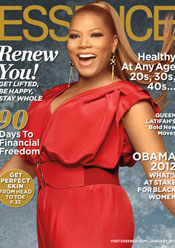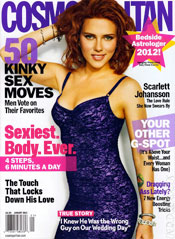Theme Essay by Lynya Floyd
Tips for Making It Through the Glossy Gates
I've been an editor at women’s magazines like Glamour, Essence, and Family Circle for more than a decade. As I worked my way up the masthead, I passed the late-night hours writing freelance stories.
 It’s been awhile since I blindly sent a pitch into the void, but I remember the awkward mix of feelings the process evoked. A fellow writer once explained that eager is how you feel when you’re waiting for your mistress to come over to an empty house. Anxious is what you are when your wife invites the mistress for dinner. With each pitch, I felt eager and anxious, thinking this could be my breakthrough, worried that my letter contained an embarrassing typo.
It’s been awhile since I blindly sent a pitch into the void, but I remember the awkward mix of feelings the process evoked. A fellow writer once explained that eager is how you feel when you’re waiting for your mistress to come over to an empty house. Anxious is what you are when your wife invites the mistress for dinner. With each pitch, I felt eager and anxious, thinking this could be my breakthrough, worried that my letter contained an embarrassing typo.
Back then, I had a routine: I’d take a walk—all right, a few paces—around my two-room studio to clear my head before sending a pitch letter. I’d take my focus off whatever story idea I needed to carefully thread on a hook in order to reel in an editor—and my next freelance check.
I’d make a cup of tea. Return a phone call. Watch a few minutes of the news. Then I’d do a final read, cut and paste it into an email, and click send.
Moments later, I’d refresh my inbox, expecting an immediate reply. But it never happened that way.
Now that I’m on the other side of the email exchange, I realize how many pitches come in to an editor. Our work days (and nights) overflow with tasks that are on tighter deadlines than the four weeks we generally have to get back to freelancers who pitch us.
But I can offer some tips for getting the best response. Some are very basic. You’d be surprised at the many obvious mistakes I’ve seen come across my desk. Pitching Essence? Don’t write in your letter that you think your story is perfect for Ebony. Spell the editor’s name right. And make sure she still works there.
There are more subtle mistakes, too, the ones we all make as writers who are passionate about the stories we choose: Telling an editor why she “must” run this story. Going on for more than a page. Trying to shoehorn an idea into the wrong magazine.
I can’t say that people who make these mistakes never sell their stories. But if you want to up your chances, here's how to avoid the less obvious missteps.
Just Do It
 I’ve picked up my telephone to find freelancers asking me how I like to be pitched (email, snail mail, or phone); whether or not I’d be interested in their ideas before they write them up; and, yes, even how to write a pitch letter.
I’ve picked up my telephone to find freelancers asking me how I like to be pitched (email, snail mail, or phone); whether or not I’d be interested in their ideas before they write them up; and, yes, even how to write a pitch letter.
You’re only frustrating the person you ultimately want on your side. Send your pitch—period. If a pitch is well-written but not right for me, I’ll often suggest other magazines writers can try. Or if a writer is on the right track, I ask him or her to please pitch us again.
I try not to let good pitches or writers go astray, and I think most magazine editors walk the same line. In fact, you have no idea how often we’re told by our supervising editors to find new talent.
Tell Me Something I Don’t Know
On the flip side, editors read the same newspapers, journals, and blogs you do. I know that diabetes disproportionately affects the African-American community. If you want to impress me, find a new spin on talking about diabetes or reveal a fact about the disease that I haven’t heard before. Talk to experts about the stories they haven’t seen written yet; dig for the blog that’s getting tons of posts but that few readers have heard of.
Very often, I get pitches for stories we’ve recently done (always check the past few issues of a magazine before sending a pitch) or those that don’t make sense for my audience.
Hint: You can look up the demographics of most magazines on their websites by searching for an electronic media kit.
Follow the Leader
Eleven years ago, I pitched an editor at YM magazine a profile about a woman who creates ice cream flavors. Since it was for a short, recurring column in the magazine, I wrote out the entire story so she could see that I’d researched the section well and how little work (I hoped) she’d have to do to place my piece.
My good luck: She liked it. My bad luck: She was changing jobs and the section she worked on might be morphing into something else. I missed out on getting that story published in YM, but I pitched that same editor at her new job at Cosmopolitan—and she assigned me a story.
Put It in the Subject Line
 In fact, my most successful pitch was to Cosmopolitan. I’d already freelanced a few stories on topics this editor gave me, such as “5 Things that Freak Men out in Bed.”
In fact, my most successful pitch was to Cosmopolitan. I’d already freelanced a few stories on topics this editor gave me, such as “5 Things that Freak Men out in Bed.”
Finally, I decided to pitch her an idea of my own. In the subject line of the email, I put this title: “5 Lies Men Learn from Porn.”
Not only did I get the story, but a variation on that title was used on the cover of the issue in which it appeared.
Editors are looking for pitches that will sell themselves. Think of the subject line of your email as a cover line on the magazine: What quick concept would get people to buy it? What would make you assign it?
Be Persistent
The first piece I ever sold was a first-person narrative about hair. (Don’t worry, I’m not going to remind you to “write what you know.”) After a few weeks, I didn’t hear back from the editor, so I called and left a voicemail.
No response. I waited another week. No response.
I told myself I’d try one more time before giving up. And as the last ring came in, she picked up the phone. She loved my pitch, but she’d been swamped with a photo shoot for the current issue. Could I call her back at a better time?
Of course! I was thrilled. But what if I hadn’t called? There’s nothing wrong with following up on a pitch you’ve sent. But you also have to…
Know When to Fold ‘Em
As I recently looked through my folder of old pitches, copied to no fewer than four different laptops over the years, I was surprised to see that I’d pitched mortgage stories long before the economic downturn.
I pitched one to Essence before I became an editor there. I thought my “Hold on to Your Home” story was perfect for the magazine. But the finance editor didn’t agree. Despite multiple emails and calls, I never got a response.
Had I put a polite date on my pitch or phone call, though, I might have sold that story elsewhere. There’s nothing wrong with emailing or calling an editor and saying, “I’d really love to sell this story. If I don’t hear back from you in a month, I’m going to pitch it to another outlet.” Editors will understand that you can’t wait around forever—just as it helps if you understand the time constraints we’re under.
Remember: Editors Are Ever Hopeful
 For me, reading pitches comes later in the day. I get to them after I handle more pressing matters like proofreading a story that has to go to the printer, conducting a deskside meeting with an expert about a hot new fitness trend or a new drug for migraines, posting to the magazine’s blog, and wading through hundreds of emails.
For me, reading pitches comes later in the day. I get to them after I handle more pressing matters like proofreading a story that has to go to the printer, conducting a deskside meeting with an expert about a hot new fitness trend or a new drug for migraines, posting to the magazine’s blog, and wading through hundreds of emails.
I still like to take a walk—all right, a quick trip to the office pantry—to clear my head before reading the stack of pitch letters or emails that have accumulated on my desk. I make a cup of tea or return a phone call. Check a few news websites.
Then I delve into the submissions pile. And although this may surprise struggling freelancers, I always have the same hope: that I’ll find the next great story or discover the next great writer. I hope for an idea that’s brilliantly pegged, easy to turn around and sell to my editor, and a breeze to be written by the author.
For an editor, finding a pitch that makes it all the way to the pages of his or her glossy magazine is like being a highroller in Vegas. (Well, almost.) It doesn’t happen that often, but when it does, everyone around the table—me, my supervising editor, and the writer—feels as if he or she has hit the jackpot.
 Lynya Floyd is the health director at Family Circle magazine, where she welcomes pitches on articles geared toward moms of tweens and teens.
Lynya Floyd is the health director at Family Circle magazine, where she welcomes pitches on articles geared toward moms of tweens and teens.
She's been a panelist at freelance journalism workshops for the American Society of Journalists and Authors, CUNY Graduate School of Journalism, the National Publicity Summit, and more.
Lynya is also a member of TW’s Advisory Board.
